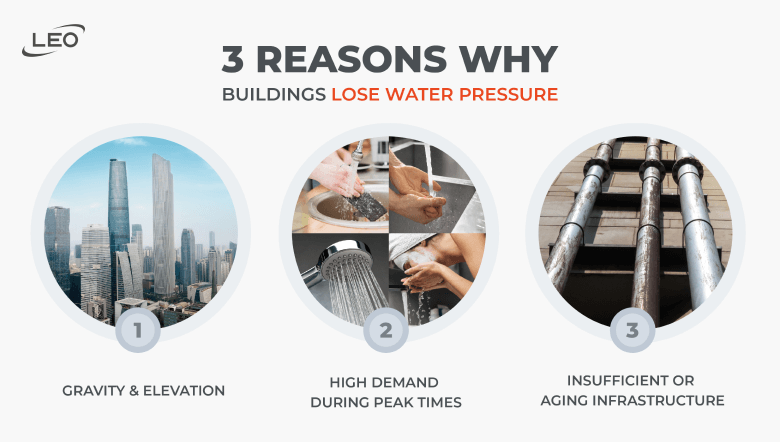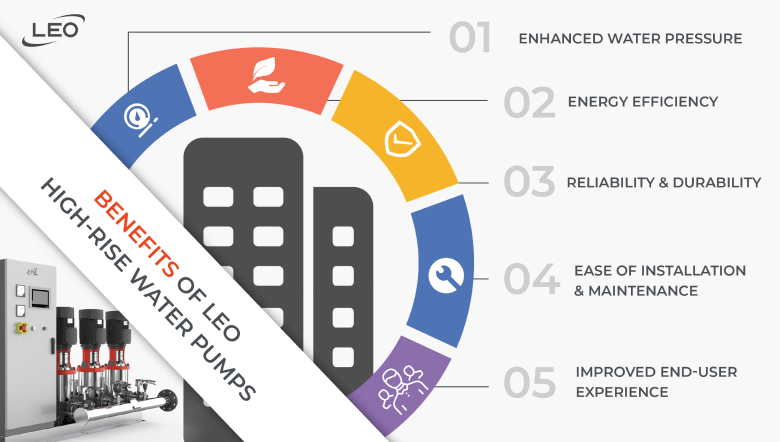Improving Water Pressure in High-Rise Buildings: Solutions for Consistent Water Flow
2024.11.15

The Challenge of Water Pressure in High-Rise Buildings
Maintaining consistent water pressure in high-rise buildings is no small task. Residents and occupants often face issues like low water flow, especially on higher floors or during peak hours. This inconvenience can affect daily activities, from showers to running appliances.
For building managers, the problem runs deeper. Pressure issues can lead to resident complaints, damage infrastructure and even drive up maintenance costs.
“Without consistent water pressure, high-rise living can feel like living in a low-tech environment. It’s a critical infrastructure issue,” notes Charles Montgomery, author of “Happy City”, a book that explores urban challenges.
The solution? Water booster system for high-rise buildings. In this article, we’ll explore:
- causes of low water pressure
- how water booster systems work
- the solutions LEO provides for a smooth, uninterrupted water supply
Keep reading to discover our projects which ensure the water pressure steady across dozens of floors.
Causes of Low Water Pressure in High-Rise Buildings
Understanding the root causes of low water pressure is essential before diving into solutions. Common factors include:

Gravity and Elevation
The higher the floor, the lower the water pressure due to gravitational pull. Water systems at ground level often struggle to pump water to upper stories, resulting in poor flow.
High Demand During Peak Times
Water pressure tends to drop during periods of high demand, such as mornings and evenings, when many residents use water simultaneously.
Insufficient or Aging Infrastructure
Many older high-rise buildings are equipped with outdated plumbing systems that weren't designed to handle modern water demands. This often results in pressure drops as the infrastructure fails to keep up.
Understanding Water Booster Pump Systems
Water booster pump systems are designed to combat low pressure and provide steady water flow across all levels of a building. They are commonly used in residential, commercial and industrial settings. But how do they work?
What is a Water Booster Pump System?

Simply put, the water supply & booster system is a specialized packaged mechanical device. It typically consists of several key components:
- Water Pumps
There are various types of pumps, such as centrifugal, multistage, or variable-speed pumps.
- Control Cabinet
In more advanced systems, the control cabinet manages the system's operation, including adjusting pump speed in variable-speed systems, monitoring system performance, and alerting operators to potential issues.
- Pressure Tank
This tank stores water and helps regulate water pressure within the system. It helps prevent the pump from running constantly by providing a buffer of pressurized water.
- Pressure Sensor
This device monitors the water pressure in the system and controls when the pump turns on and off.
- Check Valve
The check valve prevents water from flowing backward into the pump once it has been pressurized, protecting the pump from damage and ensuring efficient operation.
- Piping and Fittings
These connect the pump, pressure tank, and water supply, allowing water to flow through the system efficiently. High-quality piping ensures the system operates without leaks or pressure loss.
Moreover, a water booster pump system can be integrated with valves, gauges, flow monitoring equipment and filtration and treatment options – all mounted on a common frame for ease of installation.
Types of Water Booster Pump Systems
There are various types of water booster pump systems available, each tailored to specific needs.
Generally, we can see:
1. Single Pump Systems
Ideal for smaller buildings, these systems use one pump to maintain pressure. However, they may not be suitable for buildings with high or variable demand.
2. Multiple Pump Systems (with Variable Speed Drives)
Designed for large or high-rise buildings, these systems automatically adjust pump speed based on demand, maintaining steady pressure even during peak usage. Besides, it offers energy-efficient solutions.
Welcome to explore it more by our video of Intelligent Pressure Booster System
How a Water Pressure Booster Pump System Work
A water pressure booster pump system works by increasing the pressure of water as it flows through a building's plumbing. Here's a simple breakdown:


Water Intake: Water is drawn from the main supply line or a storage tank, entering the booster pump system.
Pressure Boosting: The pump then pushes the water through its mechanism, which increases the water's pressure. Depending on the system, this may involve single or multiple stages of boosting.
Regulation: The system’s pressure sensor or control cabinet monitors the water pressure, turning the pump on or off as needed to maintain a consistent pressure level throughout the building.
Delivery: The pressurized water is then sent through the pipes, ensuring a steady and strong water flow to all faucets, fixtures, and appliances, even in high-rise buildings or remote areas.
For learning vividly, check out our video to see how a water pressure booster pump works in action.
LEO’s Building Water Booster Pump Solutions
LEO offers a range of booster pump solutions tailored to different building types and demands. Here’s a breakdown:
1. Booster Pumps & Systems for Residential High-Rises
In residential towers, water demand varies significantly throughout the day. LEO’s booster pumps & systems are engineered to handle these fluctuations, to keep water flowing at demand.
2. Booster Pumps & Systems for Commercial Buildings
Commercial spaces, especially office complexes, face a different set of challenges, including high water use during business hours. LEO’s solutions for commercial buildings include high-efficiency pumps & systems designed for peak demand.
3. Booster Pumps & Systems for Industrial Buildings
Booster pumps and systems are essential in industrial buildings to ensure reliable water pressure across vast areas, supporting operations, sanitation, and cooling systems. LEO’s systems can handle high demand and maintain consistent flow, even under challenging conditions.
Benefits of LEO Water Booster Pump Systems
Benefits of LEO Water Booster Pump Systems

LEO’s water booster pump systems offer a host of advantages for high-rise buildings:
Enhanced Water Pressure
LEO booster systems deliver reliable water pressure to ensure consistent flow to every part of a building, solving low-pressure issues in high-rise structures or large facilities. LEO pumps can be equipped with smart controls, allowing building operators to monitor water pressure levels remotely and make real-time adjustments as needed. This not only enhances convenience but also improves system efficiency.
Energy Efficiency
Equipped with variable-speed technology and optional motors, LEO booster pumps adjust to water demand, minimizing energy use and reducing operational costs.
Reliability and Durability
Built from high-quality materials, LEO booster pumps are designed for long-term use, withstanding even the most demanding conditions.
Ease of Installation and Maintenance
LEO systems offer modular designs and pre-packaged options, making them simple to install and maintain, reducing downtime and service costs. And our systems can come with advanced monitoring tools that allow for easy maintenance. This proactive approach helps building managers identify and address issues before they lead to system failure.
Improved End-User Experience
Consistent water pressure enhances daily comfort, whether it’s for residents in high-rise apartments or workers in industrial facilities, aligning with LEO’s goal to improve overall user satisfaction. We are able to provide customizable systems to meet specific water pressure requirements.
These benefits make LEO Water Booster Pump Systems a preferred choice for efficient, reliable, and adaptable water pressure solutions in diverse settings.
Case Studies: LEO PUMP @ HIGH-RISE BUILDINGS
LEO Booster Pump Solution for Santiago 2023 Pan American and Parapan American Games Village

Background
In preparation for the Santiago 2023 XIX Pan American Games and VII Parapan American Games, four building complexes were constructed in Santiago, Chile, to serve as accommodations for the participating athletes. Following the games, these complexes will be repurposed for community use, benefiting local families eligible for Minvu subsidies. This dual-purpose initiative supports the smooth execution of international sports events and contributes to the community’s long-term welfare.
LEO Solution
To ensure reliable water supply, LEO provided four advanced booster pump systems equipped with SS Vertical Pump sets and VFD (Variable Frequency Drive) Intelligent Design technology. Each system features LVR stainless steel vertical multistage pumps (LVR 20-7 / LVR 20-6) that deliver more than 1,000 liters per minute. The system is engineered to meet the unique demands of high-rise apartments, efficiently supplying clean water to heights of up to 300 meters and withstanding temperatures up to 120°C.
Outcome
The project team successfully runes LEO’s high-performance pumping systems, ensuring timely delivery of the athlete accommodations. This resilient, efficient water system is poised to support both the games and the community in the years to come, setting a benchmark in sustainable infrastructure for future multi-purpose projects.
LEO Water Solutions for Malaysia’s Housing

Background
The Malaysian government has prioritized affordable housing to support middle-income families and first-time homebuyers. Two major initiatives are leading this effort:
PR1MA (Perumahan Rakyat 1Malaysia): Focuses on providing high-quality, affordable homes with modern living concepts for middle-income Malaysians.
Residensi Wilayah (formerly RUMAWIP): Targets affordable housing solutions for first-time buyers within urban areas.
LEO Solution
For these housing projects, LEO provided tailored water management systems to ensure efficient and reliable water supply.
Residensi Brickfields (PR1MA)
LEO Solutions: Transfer Pump Systems, Booster Pump Systems, Rainwater Irrigation System.
The Trees (Residensi Wilayah)
LEO Solutions: Transfer Pump Systems, Booster Pump Systems.
Outcome
LEO’s water solutions contribute to the sustainability and livability of these developments. By implementing systems that maximize water efficiency, LEO supports the government’s mission to improve housing quality and affordability for Malaysians.
Conclusion
Consistent water pressure is essential for the comfort and convenience of residents and tenants in high-rise buildings. Selecting the right water booster pump system can make all the difference.
LEO’s building water booster pumps offer reliable, energy-efficient, and scalable solutions tailored to your building’s unique needs. With advanced monitoring systems and a track record of success, LEO ensures you’ll never have to worry about inconsistent water flow again.
Ready to upgrade your water pressure system? Explore our full range of water booster pumps or contact a LEO specialist for a customized solution today!
Hot Media


LEO at Big 5 Global ...
2025.11.27


A Landmark LEO–Al Mo...
2025.12.02


LEO at the 138th Can...
2025.10.22


LEO Pro-Bono Water S...
2025.08.15


LEO PUMP 2024 Annual...
2025.05.14


A New Journey, A New...
2025.03.18


30 Years of LEO: lea...
2025.01.06


LEO at 30: United Th...
2024.12.16


A New Journey, A New...
2024.11.21


Showcasing Innovatio...
2024.10.25


LEO “Growing Forward...
2024.07.19


LEO Expands Global Q...
2024.09.06


LEO in Action: Power...
2024.08.02


LEO Event Highlight ...
2024.06.07


LEO PUMP at IFAT Mun...
2024.04.28


LEO PUMP at 135th Ca...
2024.04.01


LEO PUMP at MCE 2024...
2024.03.06


LEO PUMP at Big 5 Co...
2024.02.20


LEO PUMP at THE BIG ...
2023.11.16


LEO's Key Role in Wi...
2023.11.04


LEO at 134th Canton ...
2023.10.18


LEO PUMP at SNEC PV ...
2023.06.02


LEO Solution of Wate...
2022.09.28


LEO Project - Solar ...
2022.08.31


LEO Flagship Showroo...
2022.06.28


LEO Project on Power...
2022.06.22












